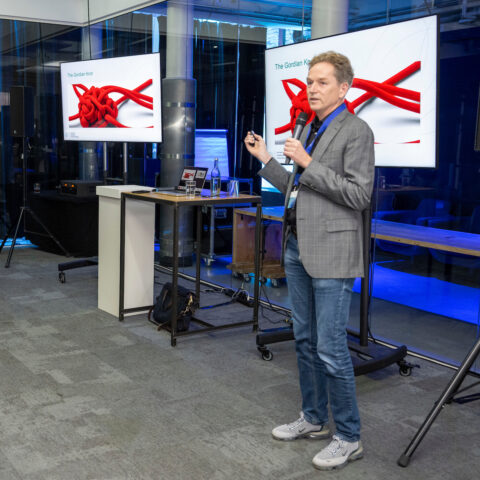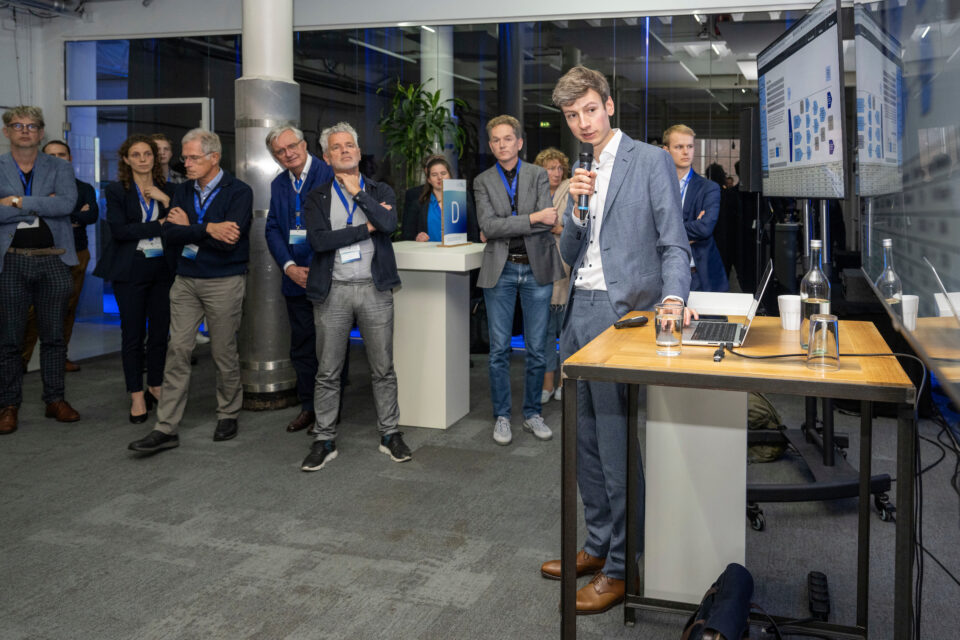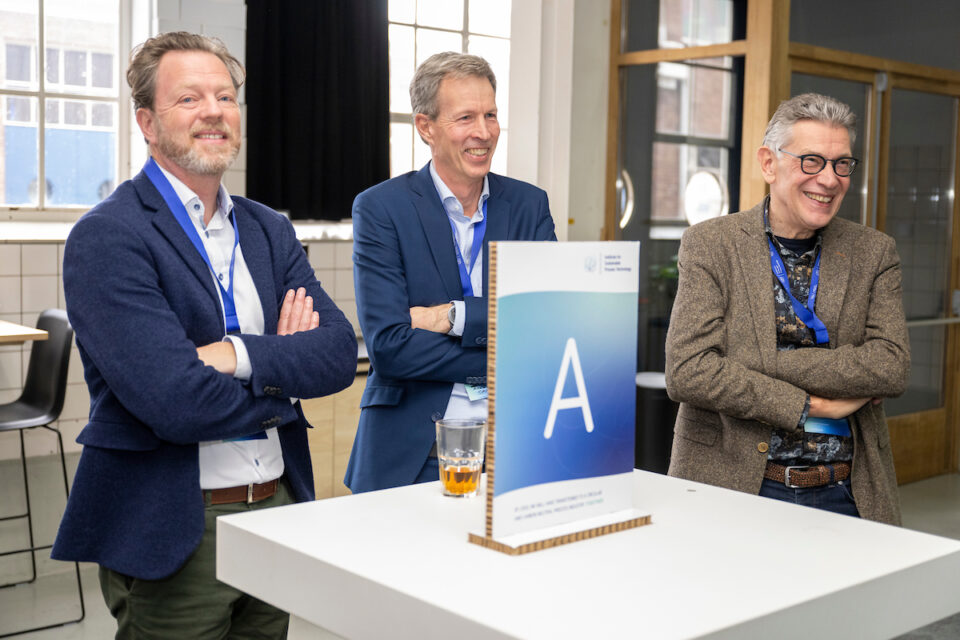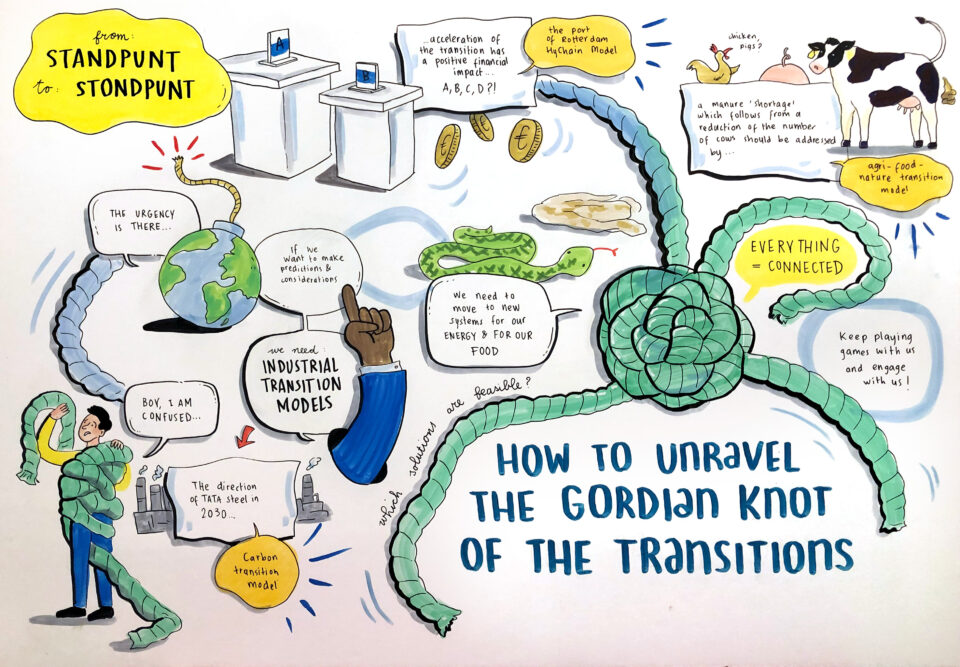We need a completely new energy and food system. But the routes toward it are often like a Gordian knot. How to make the right choices, how to untangle that knot? Transition models can be essential tools. They provide insight into the complexity of the system and map out the consequences of different scenarios. During the themed session ‘How to unravel the Gordian knot of the transition(s)’ at the ISPT Conference ’22, visitors got to work with these models.
During the ISPT Conference ’22 we presented the Carbon Transition Model to the world. This transition model (developed by Kalavasta and ISPT, in collaboration with more than 15 partners) gains insight for companies into the consequences of their choices for sustainability. Both for their own company, region and the entire Dutch industrial landscape. This insight allows them to make optimal choices.
Essential transition models
The Carbon Transition Model works on the basis of public data from all approximately 400 fossil-intensive companies in the Netherlands. With these data the model maps out raw materials, energy and emission flows from and between companies and shows how these flows change when sustainable choices are made.
ISPT believes that the Carbon Transition Model plays and indispensable role for the transition to a CO2-neutral and circular industry. It gives decision-makers an objective decision tool, in which everyone has the same facts and overviews. This allows more constructive discussions and better choices can be made.
But nowadays there are more transition models available, each with its own applications and properties. For example, QuoMare’s TEACOS-model is being used in the HyChain-project, which is exploring future renewable hydrogen value chains. And with Kalavasta’s Agrifood & Nature Transition Model, issues in the agrifood-sector can be explored.


From point of view to standing point
“The Dutch energy and raw materials system is extremely complex; everything is intertwined. That is why discussions and debates about sustainability challenges are indispensable”, says Andreas ten Cate, Program Director System Integration at ISPT. “But with such conversations it is important that we all take the same facts and figures as a starting point, that we are open to the view of others and that we are willing to let go of our own views. So from point of view to standing point. Transition models can help with that”.
The Dutch energy and raw materials system is extremely complex; everything is intertwined. That is why discussions and debates about sustainability challenges are indispensable
Andreas ten Cate, Program Director System Integration
During the themed session How to unravel the Gordian knot of the transition(s) participants were allowed to become acquainted with the 3 mentioned transition models and to experiment with them. They were presented with a total of 3 issues. They were asked to align oneself with a point of view by standing by one of the 4 tables in the room. Then, the findings of the 3 transition models (one transition model was used for each issue) were shared with them. Did these new insights change the viewpoint of the participants?
4 scenarios for Tata Steel to focus on
The answer turned out to be ‘yes’. The case about Tata Steel in particular gave a good illustration. It read as follows: “What should Tata Steel focus on in 2030?”.
The participants had 4 options:
- Tata Steel retains its current production process, but captures CO2 emissions as much as possible.
- Tata Steel switches to DRI-technology (direct reduced iron), based on natural gas
- Tata Steel switches to DRI-technology, based on grey hydrogen
- Tata Steel switches to DRI-technology, based on green hydrogen
In first instance, each option had a number of supporters in the room. Several participants opted for option 1, because they expect that hydrogen will not be sufficiently available and that there are CO2 storage options nearby. However, the majority chose for option 4, because they believe it to be the most sustainable option.

Results of the Carbon Transition Model
Participants at different tables explained their choices and a discussion followed. After that, a brief summary of the findings of the Carbon Transition Model were given on this issue. With CO2-capture (option 1), direct emissions are more than halved at Tata Steel, according to the transition model. Indirect emissions, on the other hand, are going up, but below the line a drop in emissions has been achieved. With option 2 (the use of natural gas) the total emissions actually increase. With option 3 (grey hydrogen) the direct emissions fall sharply, but the indirect emissions also rise strongly. Option 4 (green hydrogen) achieves the biggest emission reduction.
Based on the results a lot of participants changed their minds. Nobody chose option 2 or 3 anymore and significantly more people align themselves with option 4. But due to the discussion about the availability of green hydrogen in 2030, also more people are supporting option 1.
Insightful and quantifiable
“This is exactly what these transition models are intended for”, says Ten Cate after the themed session. “It is extremely important that companies learn to place their considerations in a broader context. And make or change choices based on (new) facts. Transition models help with this. They provide a very good representation of the impact your sustainability choices have on the energy or agrifood system and the infrastructure. But also how those choices relate to the choices of your neighbour and your neighbour’s neighbour. Or they show which choices you have to make in order to achieve certain objectives.”
“In other words: transition models make the context insightful and quantifiable,” he continues. “That creates understanding, both for each other and for the complexity of the task. And that provides the basis for conducting research together, exploring possible solutions and being more creative in doing so. A transition model is actually like a game, but in the real world and with real interests.”

